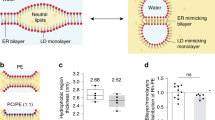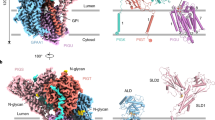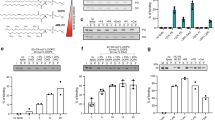Abstract
There is some discussion as to whether glycosyl-phosphatidylinositol(GPI)-anchored proteins occur in microdomains in the cell membrane1,2. These putative microdomains have been implicated in processes such as sorting in polarized cells3,4,5 and signal transduction6,7,8. Complexes enriched in GPI-anchored proteins, cholesterol and glycosphingolipids have been isolated from cell membranes by using non-ionic detergents: these complexes were thought to represent a clustered arrangement of GPI-anchored proteins9,10. However, results obtained when clustering of GPI-anchored proteins induced by antibodies or by detergents was prevented support the idea of a dispersed surface distribution of GPI-anchored proteins at steady state11,12,13. Here we use chemical crosslinking to show that membrane microdomains of a GPI-anchored protein exist at the surface in living cells. This clustering is specific for the GPI-anchored form, as two transmembrane forms bearing the same ectodomain do not form oligomers. Depletion of membrane cholesterol causes the clustering of GPI-anchored proteins to break up, whereas treatment of cells with detergent substantially increases the size of the complexes. We find that in living cells these GPI-anchored proteins reside in microdomains consisting of at least 15 molecules, which are much smaller than those seen after detergent extraction.
This is a preview of subscription content, access via your institution
Access options
Subscribe to this journal
Receive 51 print issues and online access
$199.00 per year
only $3.90 per issue
Buy this article
- Purchase on Springer Link
- Instant access to full article PDF
Prices may be subject to local taxes which are calculated during checkout



Similar content being viewed by others
References
Simons, K. & Ikonen, E. Functional rafts in cell membranes. Nature 387, 569–572 (1997).
Weimbs, T., Low, S. H., Chapin, S. J. & Mostov, K. E. Apical targeting in polarized epithelial cells: there's more afloat than rafts. Trends Cell Biol. 7, 393–399 (1997).
Lisanti, M. P., Le Bivic, A., Sargiacomo, M. & Rodriguez Boulan, E. Steady-state distribution and biogenesis of endogenous Madin–Darby canine kidney glycoproteins: evidence for intracellular sorting and polarized cell surface delivery. J. Cell Biol. 109, 2117–2127 (1989).
Brown, D. A. & Rose, J. K. Dorting of GPI-anchored proteins to glycolipid-enriched membrane subdomains during transport to the apical cell surface. Cell 68, 533–544 (1992).
Kurzchalia, T. V.et al. VIP21, a 21-kD membrane protein is an integral component of trans -Golgi-network-derived transport vesicles. J. Cell Biol. 118, 1003–1014 (1992).
Stefanova, I., Horejsi, V., Ansotegui, I. J., Knapp, W. & Stockinger, H. GPI-anchored cell-surface molecules complexed to protein tyrosine kinases. Science 254, 1016–1019 (1991).
Brown, D. The tyrosine kinase connection: how GPI-anchored proteins activate T cells. Curr. Opin. Immunol. 5, 349–354 (1993).
Rodgers, W., Crise, B. & Rose, J. K. Signals determining protein tyrosine kinase and glycosyl-phosphatidylinositol-anchored protein targeting to a glycolipid-enriched membrane fraction. Mol. Cell Biol. 14, 5384–5391 (1994).
Fiedler, K., Kobayashi, T., Kurzchalia, T. V. & Simons, K. Glycosphingolipid-enriched, detergent-insoluble complexes in protein sorting in epithelial cells. Biochemistry 32, 6365–6373 (1993).
Sargiacomo, M., Sudol, M., Tang, Z. & Lisanti, M. P. Signal transducing molecules and glycosyl-phosphatidylinositol-linked proteins form a caveolin-rich insoluble complex in MDCK cells. J. Cell Biol. 122, 789–807 (1993).
Hannan, L. A., Lisanti, M. P., Rodriguez Boulan, E. & Edidin, M. Correctly sorted molecules of a GPI-anchored protein are clustered and immobile when they arrive at the apical surface of MDCK cells. J. Cell Biol. 120, 353–358 (1993).
Mayor, S., Rothberg, K. G. & Maxfield, F. R. Sequestration of GPI-anchored proteins in caveolae triggered by cross-linking. Science 264, 1948–1951 (1994).
Mayor, S. & Maxfield, F. R. Insolubility and redistribution of GPI-anchored proteins at the cell surface after detergent treatment. Mol. Biol. Cell 6, 929–944 (1995).
Lisanti, M. P., Caras, I. W., Davitz, M. A. & Rodriguez Boulan, E. Aglycophospholipid membrane anchor acts as an apical targeting signal in polarized epithelial cells. J. Cell Biol. 109, 2145–2156 (1989).
Kurzchalia, T., Hartmann, E. & Dupree, P. Guilt by insolubility—Does a protein's detergent insolubility reflect caveolar location? Trends Cell Biol. 5, 187–189 (1995).
Rothberg, K. G., Ying, Y. S., Kamen, B. A. & Anderson, R. G. Cholesterol controls the clustering of the glycophospholipid-anchored membrane receptor for 5-methyltetrahydrofolate. J. Cell Biol. 111, 2931–2938 (1990).
Cerneus, D. P., Ueffing, E., Posthuma, G., Strous, G. J. & van der Ende, A. Detergent insolubility of alkaline phosphatase during biosynthetic transport and endocytosis. Role of cholesterol. J. Biol. Chem. 268, 3150–3155 (1993).
Hanada, K., Nishijima, M., Akamatsu, Y. & Pagano, R. E. Both sphingolipids and cholesterol participate in the detergent insolubility of alkaline phosphatase, a glycosylphosphatidylinositol-anchored protein, in mammalian membranes. J. Biol. Chem. 270, 6254–6260 (1995).
Chang, W. J., Rothberg, K. G., Kamen, B. A. & Anderson, R. G. Lowering the cholesterol content of MA104 cells inhibits receptor-mediated transport of folate. J. Cell Biol. 118, 63–69 (1992).
Smart, E. J., Mineo, C. & Anderson, R. G. Clustered folate receptors deliver 5-methyltetrahydrofolate to cytoplasm of MA104 cells. J. Cell Biol. 134, 1169–1177 (1996).
Stulnig, T. M.et al. Signal transduction via glycosyl phosphatidylinositol-anchored proteins in T cells is inhibited by lowering cellular cholesterol. J. Biol. Chem. 272, 19242–19247 (1997).
Klein, U., Gimpl, G. & Fahrenholz, F. Alteration of the myometrial plasma membrane cholesterol content with beta-cyclodextrin modulates the binding affinity of the oxytocin receptor. Biochemistry 34, 13784–13793 (1995).
Fiedler, K., Parton, R. G., Kellner, R., Etzold, T. & Simons, K. VIP36, a novel compoennt of glycolipid rafts and exocytic carrier vesicles in epithelial cells. EMBO J. 13, 1729–1740 (1994).
Scheiffele, P., Peranen, J. & Simons, K. N -glycans as apical sorting signals in epithelial cells. Nature 378, 96–98 (1995).
Fujimoto, T. GPI-anchored proteins, glycosphingolipids, and sphingomyelin are sequestered to caveolae only after crosslinking. J. Histochem. Cytochem. 44, 929–941 (1996).
Varma, R. & Mayor, S. GPI-anchored proteins are organized in submicron domains at the cell surface. Nature 394, 798–801 (1998).
Harder, T. & Simons, K. Caveolae, DIGs, and the dynamics of sphingolipid–cholesterol microdomains. Curr. Opin. Cell Biol. 9, 534–542 (1997).
Schnitzer, J. E., McIntosh, D. P., Dvorak, A. M., Liu, J. & Oh, P. Separation of caveolae from associated microdomains of GPI-anchored proteins. Science 269, 1435–1439 (1995).
Wu, M., Fan, J., Gunning, W. & Ratnam, M. Clustering of GPI-anchored folate receptor independent of both cross-linking and association with caveolin. J. Membr. Biol. 159, 137–147 (1997).
Huang, C.et al. Organization of G proteins and adenylyl cyclase at the plasma membrane. Mol. Biol. Cell 8, 2365–2378 (1997).
Matter, K., Hunziker, W. & Mellman, I. Basolateral sorting of LDL receptor in MDCK cells: the cytoplasmic domain contains two tyrosine-dependent targeting determinants. Cell 71, 741–753 (1992).
Acknowledgements
We thank G. Lewin, M. S. Bhojani and M. Wiedmann for critically reading the manuscript; W. Hunziker for plasmids pCBFL5-50 and pCBFL5-503YA; and A. Henske for technical assistance. This work was supported by the Deutsche Forschungsgemeinschaft and Human Frontier Science Program.
Author information
Authors and Affiliations
Corresponding author
Rights and permissions
About this article
Cite this article
Friedrichson, T., Kurzchalia, T. Microdomains of GPI-anchored proteins in living cells revealed by crosslinking. Nature 394, 802–805 (1998). https://doi.org/10.1038/29570
Received:
Accepted:
Issue Date:
DOI: https://doi.org/10.1038/29570
This article is cited by
-
Biocompatible and optically stable hydrophobic fluorescent carbon dots for isolation and imaging of lipid rafts in model membrane
Analytical and Bioanalytical Chemistry (2022)
-
Organization and dynamics of functional plant membrane microdomains
Cellular and Molecular Life Sciences (2020)
-
Membrane Dynamics in Health and Disease: Impact on Cellular Signalling
The Journal of Membrane Biology (2019)
-
Characterization of Split Fluorescent Protein Variants and Quantitative Analyses of Their Self-Assembly Process
Scientific Reports (2018)
-
Regulation of monoamine transporters and receptors by lipid microdomains: implications for depression
Neuropsychopharmacology (2018)
Comments
By submitting a comment you agree to abide by our Terms and Community Guidelines. If you find something abusive or that does not comply with our terms or guidelines please flag it as inappropriate.



